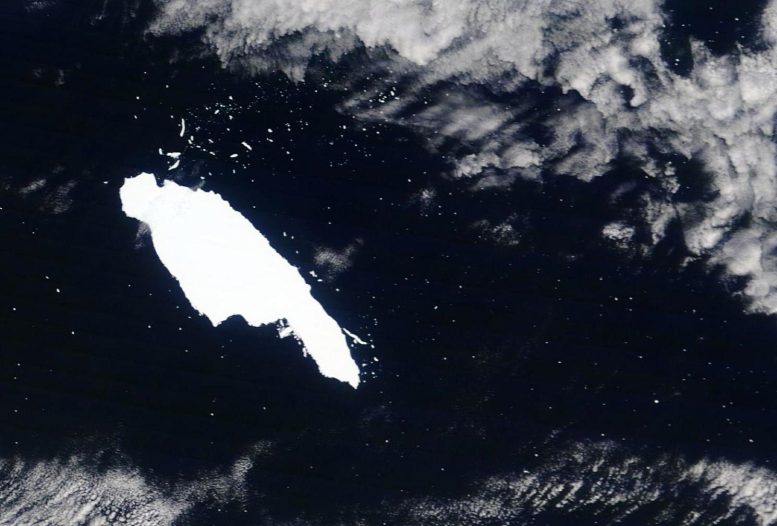
The A68A iceberg with some smaller parts of ice that have broken off around it (November 21, 2020). Credit: MODIS image from NASA Worldview Snapshots
Scientists monitoring the giant A68A Antarctic iceberg from space reveal that a huge amount of fresh water was released as it melted around the sub-Antarctic island of South Georgia.
152 billion tonnes of fresh water – equivalent to 20 x Loch Ness or 61 million Olympic sized swimming pools, entered the seas around the sub-Antarctic island of South Georgia when the megaberg A68A melted over 3 months in 2020/2021, according to a new study.
In July 2017, the A68A iceberg snapped off the Larsen-C Ice Shelf on the Antarctic Peninsula and began its epic 3.5-year, 4,000-km (2,500-mile) journey across the Southern Ocean. At 5,719 square kilometers (2,208 square miles) in extent – a quarter the size of Wales – it was the biggest iceberg on Earth when it formed and the sixth largest on record. Around Christmas 2020, the berg received widespread attention as it drifted worryingly close to South Georgia, raising concerns it could harm the island’s fragile ecosystem.
Impact of Melting on South Georgia’s Marine Habitat
Researchers from the Centre for Polar Observation and Modelling (CPOM) and British Antarctic Survey (BAS) used satellite measurements to chart the A68A iceberg’s area and thickness change throughout its life cycle. The authors show that the berg had melted enough as it drifted to avoid damaging the sea floor around South Georgia by running aground. However, a side effect of the melting was the release of a colossal 152 billion tonnes of fresh water in close proximity to the island – a disturbance that could have a profound impact on the island’s marine habitat.
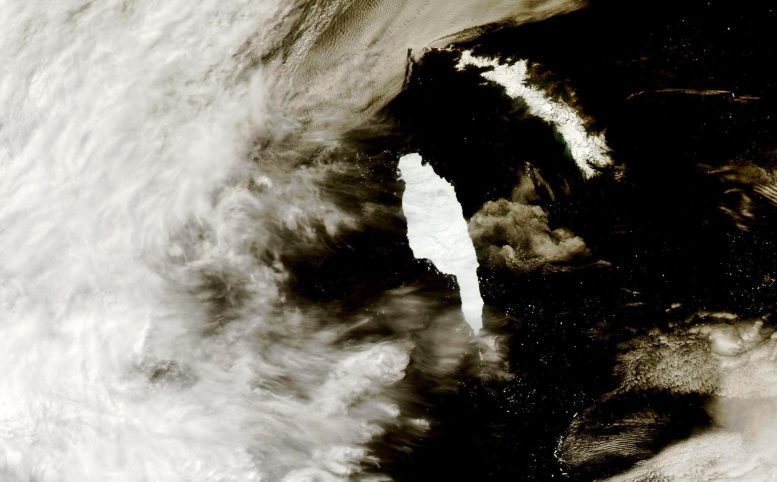
A68A iceberg approaching the island of South Georgia (December 14, 2020). The left-hand part of the image is clouds. Credit: MODIS image from NASA Worldview Snapshots
A68A had minimal melting over the first two years of its existence since it remained near to Antarctica in the chilly Weddell Sea. However, after it started moving northward over Drake Passage, it passed through warmer waters and started melting. From its original 235 m (770 ft) thickness, the iceberg thinned 67 meters (220 feet) overall, with the rate of melting dramatically increasing as the berg drifted in the Scotia Sea surrounding South Georgia.
Tracking and Observations of A68A’s Changes
Laura Gerrish, GIS and mapping specialist at BAS and co-author of the study said:
“A68 was an absolutely fascinating iceberg to track all the way from its creation to its end. Frequent measurements allowed us to follow every move and break-up of the berg as it moved slowly northwards through iceberg alley and into the Scotia Sea where it then gained speed and approached the island of South Georgia very closely.”
Thinning and breakage of the A68A iceberg over time. Melt rates increase sharply once the iceberg is drifting in open ocean north of the Antarctic peninsula. Iceberg thickness was derived from satellite altimetry data from Cryosat-2 and ICESat-2. Iceberg shape and size were sourced from Sentinel-1, Sentinel-3 and MODIS satellite data. Credit: Anne Braakmann-Folgmann CPOM
Risks and Interactions with South Georgia
If an iceberg’s keel is too deep it can get stuck on the sea floor. This can be disruptive in several different ways; the scour marks can destroy fauna, and the berg itself can block ocean currents and predator foraging routes. All of these potential outcomes were feared when A68A approached South Georgia. However, this new study reveals that it collided only briefly with the sea floor and broke apart shortly afterward, making it less of a risk in terms of blockage. By the time it reached the shallow waters around South Georgia, the iceberg’s keel had reduced to 141 meters (463 feet) below the ocean surface, shallow enough to avoid the seabed which is around 150 meters (490 feet) deep.
Ecological Implications and Future Research
Nevertheless, the colossal iceberg’s presence would undoubtedly have had an effect on the ecosystem and wildlife in the area of South Georgia. When icebergs break off from ice shelves, they move with the wind and ocean currents, releasing cold, fresh meltwater as they do so. Around the iceberg, this mechanism encourages biological production and has an impact on the local water circulation. The iceberg discharged an astonishing 152 billion tonnes of fresh water and nutrients at its height, melting at a pace of 7 meters per month.
Anne Braakmann-Folgmann, a researcher at CPOM and PhD candidate at the University of Leeds’ School of Earth and Environment, is the lead author of the study. She said:
“This is a huge amount of melt water, and the next thing we want to learn is whether it had a positive or negative impact on the ecosystem around South Georgia.
“Because A68A took a common route across the Drake Passage, we hope to learn more about icebergs taking a similar trajectory, and how they influence the polar oceans.”
Comprehensive Satellite Monitoring of A68A
The journey of A68A has been charted using observations from 5 different satellites. The iceberg’s area change was recorded using a combination of Sentinel-1, Sentinel-3, and MODIS imagery. Meanwhile, the iceberg’s thickness change was measured using CryoSat-2 and ICESat-2 altimetry. By combining these measurements, the iceberg’s area, thickness, and volume change were determined.
Tommaso Parrinello, CryoSat Mission Manager at the European Space Agency, said:
“Our ability to study every move of the iceberg in such detail is thanks to advances in satellite techniques and the use of a variety of measurements. Imaging satellites record the location and shape of the iceberg and data from altimetry missions add a third dimension as they measure the height of surfaces underneath the satellites and can therefore observe how an iceberg melts.”
Reference: “Observing the disintegration of the A68A iceberg from space” by A. Braakmann-Folgmann, A. Shepherd, L. Gerrish, J. Izzard and A. Ridout, 10 January 2022, Remote Sensing of Environment.
DOI: 10.1016/j.rse.2021.112855

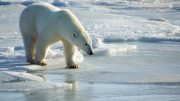

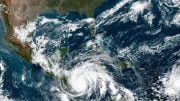

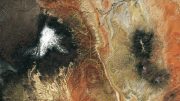
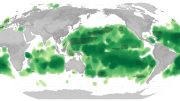


The world is just balancing itself out from global warming.
People are reacting to this with naive wonderment and amazement as if it is normal. The amount of water this berg will release will add to sea rise and the fresh water it is depositing into the ocean will adversely effect ocean circulating currents. More and more of these massive ice bergs will break off in the near future. This is very bad news for humanity, most of who remain largely ignorant of the devastating impacts of abrupt exponential climate change. Climate change will more than likely drive humans to extinction in the next 10-20 years.
once the iceberg is in the water in 2017, it would have displaced it’s weight, irrespective of whether it’s solid or liquid the sea level rose if it was entirely on land, which isn’t clear. Also, the volume of ice is less than water, which is why it floats. (Archimedes principle) this is the 6th largest on record. What happened to the others, the world did not end. Of course I live in Canada in an area 10 thousand years was under 2km of ice, do you think we need to bring back the ice to Canada, Europe, Siberia? Much of northern Canada is still rising/rebounding, in some case at a rate of 6 inches a year from the impact of the weight of the ice 1000’s of years ago. if you go to see Churchill MB, it is amazing to see mooring anchors, placed there during fur trade in 1700’s that are along away from the sea because of the rise in the land…pronouncements of imminent world end and extinction are not accurate by most i have read. Rate of change may not be natural but earth has been warming since last ice age, and any paleontologist will confirm the earth is now much cooler now than on its 5 billion average, maybe it is now cooler because the plants cleaned carbon from air. There used to be a display at the Royal Tyrrell Museum that showed the earth’s historical temperature, but I haven’t been there since my children were little a decade ago. it would be worthwhile understanding before commenting.
“The amount of water this berg will release will add to sea rise and the fresh water it is depositing into the ocean will adversely effect [sic] ocean circulating currents.”
While you are providing us with ‘facts,’ how about telling us how much this caused sea level to rise? Just how “adversely” will it affect ocean currents? How about some numbers instead of frantic hand waving?
You said, “Climate change will more than likely drive humans to extinction in the next 10-20 years.” What is your source for this claim? Greta Thunberg, who claims she can see invisible CO2, or that paragon of logic, practicing scientist, dabbling in politics for amusement, AOC?
As these icebergs break off, they should be towed to key places in the world that lack fresh water and as the ice melts the fresh water be used for farming in that area. Instead of raising the sea levels the water will quench arid land.
How many tugboats does it take to move a large ship to the dock in a port? How many do you suppose it would take to move something one-quarter the size of Wales? Think of all the CO2 would give off traveling several thousand miles pushing the iceberg!
When it is all done, it probably would have been cheaper to build a desalinization plant!
Oh yes, the melt water. What doesn’t end up in the atmosphere from evaporation and transpiration will move underground until it intercepts streams and rivers and make its way to the ocean. It delays the arrival in the ocean, but doesn’t prevent it.
“… 61 million Olympic sized swimming pools …”
The whole point of using an analogy, or equivalence, is to provide something the reader can subjectively relate to. Nobody can really relate to 61 million of anything, let alone large swimming pools. Besides that, the author mixed units, using the area of Wales and the weight of the volume of water in swimming pools. Neither of those choices really provide a reader with something that they can relate to. The best that can be hoped for is that readers come away with the idea that it is a really big number.
It would probably be more appropriate to provide it as the percentage of the volume of ice in Antarctica. However, that wouldn’t be a big number, even though it would be accurate. That wouldn’t carry the same scare factor as the number of ping pong balls with the same volume as the iceberg.
What I find hilarious is how meaningless the numbers are. Do people really believe that the oceans are going to rise evenly around the globe and some volume analysis provides this information? I fell over laughing at an article some time back because it stressed how catastrophic the accelerated loss of ice in the north pole was. If you don’t know why this is funny please stop talking about this issue. You’re only advertising your stupidity. Don’t get me wrong, the fear-mongering is occasionally entertaining, but please stop producing articles that imply a pier reviewed consensus, because you make the real scientist look like @ssholes and it’s not appreciated. Yes, yes, fresh water affects the Eco systems of some shallow salinity dependent reefs and such, but instead of clinging on to your “The end of the world is coming” cardboard signs, try admitting that you really have no idea what might happen and you just wanted inform people that they should probably sell their ocean front property before our axis stops being our ally.
When I was young in the 50’s the snow went up to 1 story during the winter. I visited that area 50 years later the snow only went up a meter. In the 50’s possums lived no further than mid way up the U.S. Now they live in Canada. Because, the climate is changing. You can think it will be business as usual if you so wish, but it isn’t. You will see more climate change as the years go by.
Mark. My. Words.
You said, “In the 50’s possums lived no further than mid way up the U.S. Now they live in Canada. Because, the climate is changing.”
From https://nationalzoo.si.edu/animals/virginia-opossum
“Although its name might suggest otherwise, Virginia opossums can be found from Costa Rica to Mexico, as well as in the United States, east of the Rocky Mountains and north into Ontario, Canada.”
From “A Field Guide to the Mammals,” Burt and Grossenheider (1952) the map shows the opposum range up to the Great Lakes, NOT “mid way up the U.S.” It appears that the Great Lakes are a substantial barrier and there has been little change since the 1950s.
As to the depth of snow, I lived in Northern Illinois in the late-’40s and early-’50s. While the snow seemed deep at the time, it was because I was only half as tall as I am as an adult. I never saw snow up to the second floor as a child!
Your fact-free testimonial is either a fabrication or an exaggeration resulting from a poor memory from someone who was much smaller in the ’50s.
I guess that when we have power over the “sun” – is when we can help climate change on this wonderful “God given” planet!!